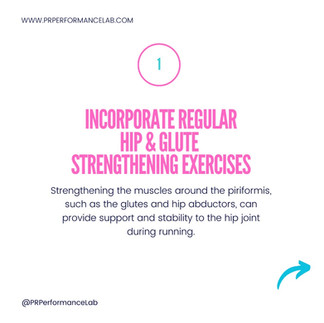Pain in the butt? Piriformis?
- Dayna Player Robinson

- May 22, 2023
- 2 min read

Unveiling the Piriformis:
Understanding its Location and Role in Running
As a runner, understanding the anatomy and function of key muscles can greatly enhance your training and performance. In this post, we will shine a spotlight on the piriformis muscle—its location in the body and its crucial role in running mechanics.
The Location of the Piriformis Muscle: The piriformis muscle is located deep within the gluteal region, beneath the larger gluteus maximus muscle. It originates from the sacrum (the triangular bone at the base of the spine) and attaches to the upper part of the femur (thigh bone). Its positioning allows it to act as a hip rotator and stabilizer.
The Role of the Piriformis Muscle in Running: The piriformis muscle plays a vital role in running mechanics by contributing to hip stability and leg movement. Here are two key functions:
Hip Rotation: During the running gait, the piriformis muscle helps rotate the thigh outward (external rotation) as your foot strikes the ground and propels you forward. This movement assists in maintaining proper alignment and balance, reducing the risk of injury. This is the Cross over part of the gait.
Pelvic Stabilization: The piriformis muscle also aids in stabilizing the pelvis, helping to maintain a steady and efficient stride. It works in synergy with other hip muscles to support proper alignment and minimize excessive movements during running. This is the hip drop part of the gait.
The piriformis muscle, located deep within the gluteal region, plays a crucial role in running. It facilitates hip rotation and pelvic stabilization, both of which contribute to efficient and injury-free running. Understanding its function can help you appreciate the importance of maintaining its flexibility and strength. If you experience any pain or discomfort related to the piriformis muscle, seek professional guidance to address the issue promptly. By nurturing and properly caring for your piriformis muscle, you can enhance your running experience and stride with confidence.
See mobility & strength exercises to help with Piriformis Syndrome HERE.
Disclaimer: The information provided in this blog post is for educational purposes only and should not replace professional medical advice. If you have specific concerns or conditions, please consult with a professional for personalized guidance.
References:
Neumann, D. A. (2017). Kinesiology of the Musculoskeletal System: Foundations for Rehabilitation. Elsevier Health Sciences.
Fredericson, M., & Wolf, C. (2005). Iliotibial band syndrome in runners: innovations in treatment. Sports Medicine, 35(5), 451-459.
It's important to improve your running form when having Piriformis pain. Our Running Assessment has everything to help you: cues to think about while running & strengthening exercises specifically for you!
Want more help?
Join our Running Workshop here!
Or
Learn how you can run more efficiently Running Assessment
Or
Get your FREE Strength Assessment here!
Or
Join our online 12-week strength program here!

































Comments